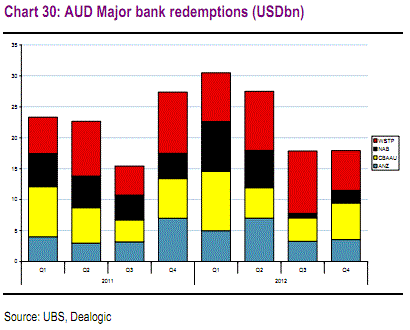Australia’s big four banks found some funding relief today with covered bond issues in both Europe and locally. From the AFR:
Commonwealth Bank of Australia’s five-year covered bond, launched today, is a landmark deal for more reasons than one. For starters, it marks the first time that a local bank has issued covered bonds in its own market.
…In a week where global credit spreads have proved resilient despite negative headlines out of Europe, Australian bank spreads have been clear laggards – and in particular the physical bond margins of existing major bank debt.
The reason is funding pressure. Australian bank spreads have widened this week not because of Europe but because of their need to get ahead on their fund raising is expected to prompt an avalanche of issuance, evidenced by CBA’s bond ssue.
Having already exhausted the US covered bond and European covered bond markets in the short term (issuing close to $8 billion of bonds since early November) and with non-covered bond funding in those markets still too expensive to stomach, the banks are now turning their attention to the local market.
It was expected that the major banks would use the domestic investor base to raise their non-covered bond funding because the domestic market accepts lower rates for this form of funding.
…Now, The Financial Review DealBook understands, the pricing has been revised back inwards – to 175 basis points and the chatter is the deal is set to be a big one with an order book of over $3.5 billion according to market sources.
Jonathon Shapiro is doing some good work. What a relief to actually hear the real reasons behind the banks struggle to find affordable money. That is, they need it and have mismanaged the search.
This issue raises several questions. If the banks are prepared to pay 175bps over swap for covered bonds then unsecured funding is now beyond reach. Shapiro speculates that unsecured debt might cost 200bps over but according to my sources unsecured funds typically cost half to two thirds more than covered. You do the maths.
There is also the issue of why the banks are issuing in Australia at all. Basically, according to Banking Day:
On the other hand, ANZ and Westpac have effectively closed the US market for Aussie covered bonds with poorly executed debut issues that have since seen credit spreads widen to 150 bps, incurring losses for investors.
Thankfully, the covered bond market in the US is only in its infancy and with the investor groups being different the banks should still be able to issue unsecured bonds. Unsecured issuance is impossible in Europe at the present time, with only covered bonds being accepted by investors.
The banks now need to move quickly to issue unsecured bonds in other markets to prevent these latest Euromarket issues from setting a new pricing benchmark. The 220 bps Aussie cost suggests a 270 bps spread for a five-year unsecured bond.
Five-year credit default swaps for the major banks are currently at 175 bps, domestic secondary market spreads for five-year bonds are around 160 bps. NAB issued for three years in mid-December at 130 bps over swap.
The banks need to confirm these pricing levels quickly to avoid the worst funding cost blow-out seen yet.
Still, ANZ also did a deal last night for a covered bond in Switzerland that was well inside the euro deal last week…AUD 735 mill for 3 years at 151 and 7 years at 205 swapped back into AUD. That would generate a mid point for a 5 year, if they’d have issued one, around 175 so about 45 points inside last weeks deals. Not terribly large of course but it all adds up. By my calculations (assuming CBA goes the whole hog) that’s 13.5 billion so far raised this year.
But the banks do need to move quickly. As the following chart shows, issuance this year is front loaded:

And there’s bound to be some spillover from the very slack second half issuance of 2011 as well.
There’s more than one rate cut in the pipeline for sure and it’s fair bet we won’t see much of it.

